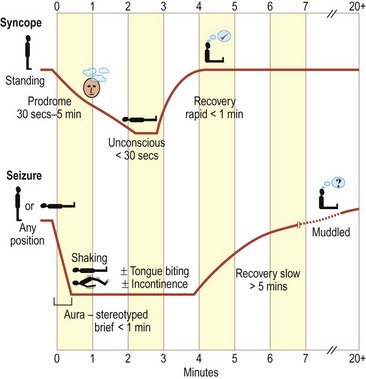Blackouts and ‘funny do’s’
Blackouts are one of the most common presentations in neurology, accounting for 18% of new neurological outpatients. The most common causes are seizures or syncope. While a list of possible causes is long, the clinical history, particularly with an account from a witness, will usually define the nature of the attack and direct investigations.
Types of blackouts and ‘funny do’s’
Episodes with collapse
Tonic-clonic seizure
These may occur at any time and in any position (Fig. 1). The patient may have a warning (aura), such as a smell or taste or simply a strange feeling (see below). The aura is usually brief (a few seconds). There may be no warning. The patient may be observed to go blank or be lip smacking before losing consciousness. The patient then goes stiff and lets out a grunt. The arms and legs go stiff for a period and the jaw is clenched tight. This may be followed by a jerking of the limbs. This usually goes on for 2–3 min. The patient usually goes into a deep sleep. On coming round, the patient is muddled. Patients frequently bite their tongue and pass urine.
Syncope
There may be factors in the situation of the blackout that suggest syncopal episodes:
 If it occurred after prolonged standing, in a hot place or after some distress such as the sight of blood. All these suggest a vasovagal syncope.
If it occurred after prolonged standing, in a hot place or after some distress such as the sight of blood. All these suggest a vasovagal syncope. If it is preceded by a palpitation, occurs without any prodrome or occurs with exertion – all suggest cardiac syncope, e.g. due to an arrhythmia or obstructive cardiomyopathy.
If it is preceded by a palpitation, occurs without any prodrome or occurs with exertion – all suggest cardiac syncope, e.g. due to an arrhythmia or obstructive cardiomyopathy.Stay updated, free articles. Join our Telegram channel

Full access? Get Clinical Tree





